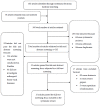Mosquito-Borne Viral Pathogens Detected in Zambia: A Systematic Review
- PMID: 34451471
- PMCID: PMC8401848
- DOI: 10.3390/pathogens10081007
Mosquito-Borne Viral Pathogens Detected in Zambia: A Systematic Review
Abstract
Emerging and re-emerging mosquito-borne viral diseases are a threat to global health. This systematic review aimed to investigate the available evidence of mosquito-borne viral pathogens reported in Zambia. A search of literature was conducted in PubMed and Google Scholar for articles published from 1 January 1930 to 30 June 2020 using a combination of keywords. Eight mosquito-borne viruses belonging to three families, Togaviridae, Flaviviridae and Phenuiviridae were reported. Three viruses (Chikungunya virus, Mayaro virus, Mwinilunga virus) were reported among the togaviruses whilst four (dengue virus, West Nile virus, yellow fever virus, Zika virus) were among the flavivirus and only one virus, Rift Valley fever virus, was reported in the Phenuiviridae family. The majority of these mosquito-borne viruses were reported in Western and North-Western provinces. Aedes and Culex species were the main mosquito-borne viral vectors reported. Farming, fishing, movement of people and rain patterns were among factors associated with mosquito-borne viral infection in Zambia. Better diagnostic methods, such as the use of molecular tools, to detect the viruses in potential vectors, humans, and animals, including the recognition of arboviral risk zones and how the viruses circulate, are important for improved surveillance and design of effective prevention and control measures.
Keywords: Flaviviridae; Phenuiviridae; Togaviridae; Zambia; arboviruses; mosquito-borne.
Conflict of interest statement
The authors declare no conflict of interest.
Figures
References
-
- Chandler L.J. Arthropod-Borne Virus Information Exchange December 1997. Centers for Disease Control and Prevention (U.S.gov); Atlanta, GA, USA: 1997.
-
- Marchi S., Trombetta C.M., Montomoli E. In: Emerging and Re-Emerging Arboviral Diseases as a Global Health Problem. Majumder M.A.A., editor. IntechOpen; London, UK: 2018. pp. 25–46. Public Health.
-
- Heinrich N., Saathoff E., Weller N., Clowes P., Kroidl I., Ntinginya E., Machibya H., Maboko L., Löscher T., Dobler G. High seroprevalence of Rift Valley fever and evidence for endemic circulation in Mbeya region, Tanzania, in a cross-sectional study. PLoS Negl. Trop. Dis. 2012;6:e1557. doi: 10.1371/journal.pntd.0001557. - DOI - PMC - PubMed
Publication types
Grants and funding
LinkOut - more resources
Full Text Sources




